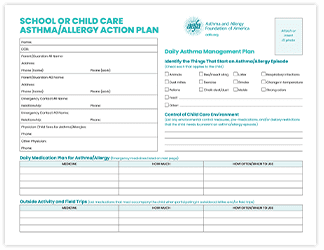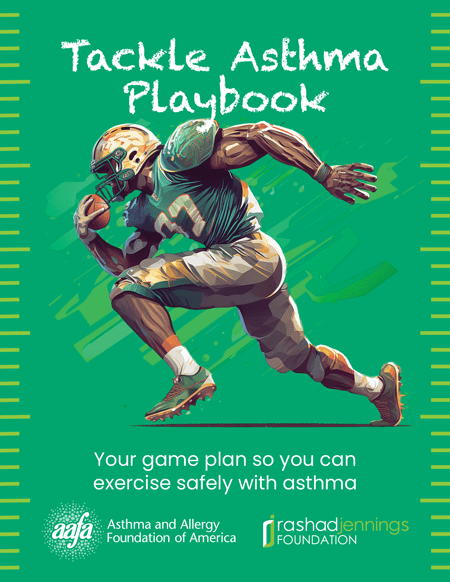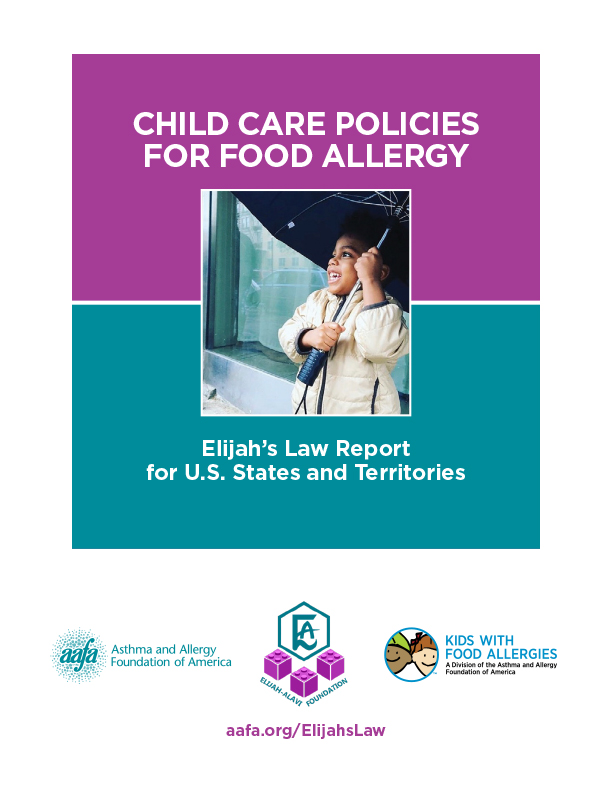Asthma
Resources for Early Childhood Education and Child Care
Allergic diseases, such as asthma, food allergies, and atopic dermatitis (eczema), are some of the most common chronic diseases in American children.
- 5.1 million children have asthma
- 5.6 million children have food allergies
- 9.6 million have atopic dermatitis
The Asthma and Allergy Foundation of America (AAFA) created this list of resources to help early childhood education and child care centers manage asthma and allergies in the classroom.
Emergency Action Plans
Asthma Action Plan (printable PDF)
This plan has information and instructions on how to manage your asthma. Asthma Action Plans tell school staff and other caregivers about your child’s asthma. You can give it to teachers, school nurses, and afterschool care staff. (Available in English and Spanish)
School or Child Care Asthma/Allergy Action Plan (printable PDF)
 This card has the information you need to care for a young child with asthma or allergies. The card has sections for information about a medicine plan and a list of the child’s signs and symptoms. It also has steps on how to handle asthma and allergy emergencies.
This card has the information you need to care for a young child with asthma or allergies. The card has sections for information about a medicine plan and a list of the child’s signs and symptoms. It also has steps on how to handle asthma and allergy emergencies.
Resources for Managing Asthma and Allergies
Asthma can start at any age, even in infancy. But asthma in infants can look different than asthma in children and adults. This can also make it harder to recognize. By knowing how to manage asthma and spot symptoms, you can successfully manage asthma in the young children in your care. Learn more about the signs and symptoms of asthma in a baby or toddler.
Your Guide to Managing Asthma (printable PDF)
 We created this guide to help you know more about managing a child’s asthma. Learn about causes, triggers, symptoms, treatment, and more.
We created this guide to help you know more about managing a child’s asthma. Learn about causes, triggers, symptoms, treatment, and more.
Nebulizers for the Treatment of Asthma (printable PDF)
 Nebulizers can be used for the treatment of asthma. A nebulizer machine, or “breathing machine,” turns liquid asthma medicine into a mist. You then breathe in the medicine through a mask or mouthpiece. Nebulizers may be easier to use than asthma inhalers for some people. This handout provides information on different types of nebulizers and how to use and clean a nebulizer.
Nebulizers can be used for the treatment of asthma. A nebulizer machine, or “breathing machine,” turns liquid asthma medicine into a mist. You then breathe in the medicine through a mask or mouthpiece. Nebulizers may be easier to use than asthma inhalers for some people. This handout provides information on different types of nebulizers and how to use and clean a nebulizer.
How to Correctly Use Your Asthma Devices (printable PDF)
Correct inhaler and nebulizer technique helps get asthma medicines into the lungs where it needs to be. This guide outlines the correct techniques for using different asthma medicine delivery devices and equipment.
Tackle Asthma Playbook (printable PDF)
 AAFA partnered with running back and Dancing with the Stars winner Rashad Jennings to create this game plan so kids can exercise safely with asthma. Follow these steps to tackle asthma.
AAFA partnered with running back and Dancing with the Stars winner Rashad Jennings to create this game plan so kids can exercise safely with asthma. Follow these steps to tackle asthma.
Creating an Asthma and Allergy Friendly Environment
Asthma-Friendly Child Care: A Checklist for Providers (printable PDF) This checklist is easy for child care providers to use. It helps identify asthma and allergy triggers and gives tips to make your child care center a safe and healthy environment for children. (Available in English and Spanish)
This checklist is easy for child care providers to use. It helps identify asthma and allergy triggers and gives tips to make your child care center a safe and healthy environment for children. (Available in English and Spanish)
Is It Asthma, Allergies, a Cold, COVID-19, the Flu, or RSV? (printable PDF) Because some symptoms are similar, our symptom comparison chart can help determine if staff or a student may be feeling symptoms of asthma, allergies, or a respiratory illness like COVID-19, the flu, a cold, or RSV. You will also find tips on how to help stop the spread of respiratory illnesses. (Download includes English and Spanish)
Because some symptoms are similar, our symptom comparison chart can help determine if staff or a student may be feeling symptoms of asthma, allergies, or a respiratory illness like COVID-19, the flu, a cold, or RSV. You will also find tips on how to help stop the spread of respiratory illnesses. (Download includes English and Spanish)
COVID-19 and Asthma Toolkit for Schools (printable PDF) This toolkit and resource guide is designed to help schools create environments that help protect students and staff with asthma while preventing the spread of COVID-19.
This toolkit and resource guide is designed to help schools create environments that help protect students and staff with asthma while preventing the spread of COVID-19.
Food Allergy Resources
About 5.6 million children have food allergies. With these numbers, there’s a good chance many classrooms and care centers in the U.S. will have a student with a food allergy.
Food Allergy Anaphylaxis in Infants and Toddlers
Anaphylaxis is a severe allergic reaction that can be life-threatening if not treated quickly and properly. Epinephrine is a safe, first-line treatment to stop serious symptoms. But the signs and symptoms of anaphylaxis can be harder to recognize in infants and toddlers. Learn more about our Food Allergy Anaphylaxis in Infants and Toddlers.
Guides to Managing Common Food Allergens
These nine foods cause the most food allergy reactions in the United States:
- Milk
- Eggs
- Peanuts
- Tree nuts (examples: almonds, walnuts, pecans)
- Sesame
- Soy
- Wheat
- Fish (examples: bass, flounder, cod)
- Crustacean shellfish (examples: crab, lobster, shrimp)
Our allergen guides have information about the symptoms of an allergic reaction, preventing reactions, how to read labels, and a list of ingredient names that might appear on labels.
Potential Food Allergens in School Crafts and Activities (printable PDF)
 Common food allergens can be found in arts and craft supplies, as well as many classroom projects and activities. Learn what may contain food allergens, as well as alternatives and precautions. Printable PDF available for free download.
Common food allergens can be found in arts and craft supplies, as well as many classroom projects and activities. Learn what may contain food allergens, as well as alternatives and precautions. Printable PDF available for free download.
Non-Food Rewards for Children With Food Allergies (printable PDF)
 As recommended by the CDC, non-food rewards are great for creating a safe and inclusive classroom. This resource lists several non-food reward ideas and includes a PDF you can print for reference. Printable PDF available for free download.
As recommended by the CDC, non-food rewards are great for creating a safe and inclusive classroom. This resource lists several non-food reward ideas and includes a PDF you can print for reference. Printable PDF available for free download.
Find more resources on our Kids With Food Allergies (KFA) School Resources for Schools and Care Centers site (Visit kidswithfoodallergies.org)
Elijah’s Law Report: Preventing Food Allergy Reactions in Child Care Programs (printable PDF)
Our report looks at state and U.S. territory child care licensing regulations against nine policy standards. The standards aim to protect children with food allergies in child care settings. The report also includes an advocacy toolkit to help you advocate for Elijah’s Law in your home state.
Fun Ways to Teach Children About Asthma and Allergies
Help kids better understand asthma or food allergies and build compassion for their classmates through fun activity books, videos, online games, and downloadable resources.
Ally & Andy’s Asthma and Allergy Activity Book (printable PDF)
 This coloring and activity book gives children and families a fun way for children to learn common asthma triggers. It also helps them learn how to manage their asthma and food allergies. (Available in English, Spanish, and Arabic)
This coloring and activity book gives children and families a fun way for children to learn common asthma triggers. It also helps them learn how to manage their asthma and food allergies. (Available in English, Spanish, and Arabic)
Updated as of March 2024.









 Click for larger image
Click for larger image
